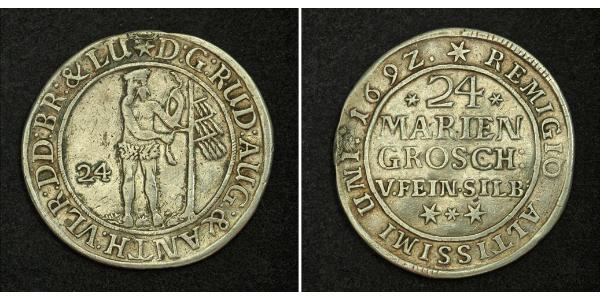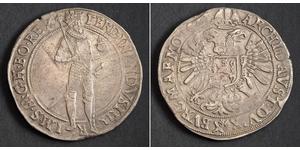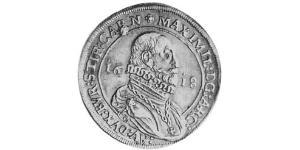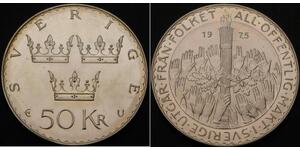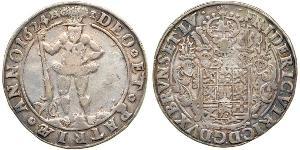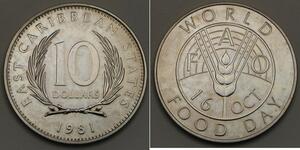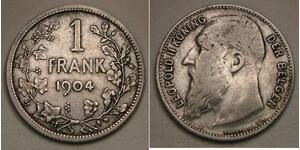(продана за $78.0)
1692, Brunswick-Wolfenbuttel, Rudolph Augustus. Silver 2/3 Thaler Coin. VF-
Mint year: 1692
Reference: Welter 2079, KM-559.
Mint Place: Brunswick-Wolfenbuttel
Denomination: 2/3 Thaler (24 Mariengroschen)
Ruler: Rudolph Augustus & Anton Ulrich (joint rule)
Ruler: Rudolph Augustus and his brother Anthony Ulrich as his co-regent.
Condition: Removed suspension loop, lightly deformed, scratches, otherwise VF+
Weight: 12,57gm
Diameter: 38mm
Material: Silver
Obverse:Standing half-naked wildman (or woodwose), bending branches of a tree to his left. Value (24) to his right.
Legend: * D:G : RUD . AUG . & ANTH : VLR : DD . BR : & LU
Reverse: Value (*24*), above denomination (MARIEN GROSCH:) and fractional silver mark value (V.FEIN.SILB) above privy mark (***).
Legend: * REMIGIO ALTISSIMI UNIT ("Crew of the highest one!") 169Z .
The wild man or woodwose is a mythological figure that appears in the artwork and literature of medieval Europe. Images of wild men appear in the carved and painted roof bosses where intersecting ogee vaults meet in the Canterbury Cathedral, in positions where one is also likely to encounter the vegetal Green Man. The wild man, pilosus or "hairy all over," and often armed with a club, was a link between civilized humans and the dangerous elf-like spirits of natural woodland, such as Puck. The image of the wild man survived to appear as supporter for heraldic coats-of-arms, especially in Germany, well into the 16th century. Early engravers in Germany and Italy were particularly fond of wild men, wild women, and wild families, with examples from Martin Schongauer and Albrecht Dürer among others.
The earliest medieval concepts of the wild man focus on him as a normal human gone wild by madness, as in the Biblical story of Nebuchadnezzar; this first occurs in Celtic societies in the High Middle Ages. These Celtic stories attribute to the wild man poetic or prophetic powers. The 9th-century Irish tale Buile Shuibhne (The Madness of Sweeney) describes how Sweeney, the pagan king of the Dál nAraidi in Ulster, assaults the Christian bishop Ronan Finn and is cursed with madness as a result. He spends many years traveling naked through the woods, where he composes verse. The Welsh told a similar story about Myrddin Wyllt, the origin of the Merlin of later romance. In these stories Myrddin is a warrior in the service of King Gwenddoleu ap Ceidio at the time of the Battle of Arfderydd. When his lord is killed at the battle, Myrddin takes to the Caledonian Forest in a fit of madness which bestows him with the ability to compose prophetic poetry; a number of later prophetic poems are attributed to him. The Life of Saint Kentigern includes almost the same story, though here the madman of Arfderydd is instead called Lailoken, which may be the original name. The fragmentary 16th-century Breton text An Dialog Etre Arzur Roe D'an Bretounet Ha Guynglaff (Dialog Between Arthur and Guynglaff) tells of a meeting between King Arthur and the wild man Guynglaff, who predicts events which will occur down to the 16th century.
em>.
Rudolph Augustus (16 May 1627, Hitzacker – 26 January 1704) was duke of Brunswick-Lüneburg from 1666 until his death. He ruled over the Wolfenbüttel subdivision of the duchy. In 1685, he made his younger brother Anthony Ulrich his co-regent. Rudolph Augustus was the son of Augustus the Younger, Duke of Brunswick-Lüneburg.

|
Добавив:
anonymous 2015-01-06 |
Одна з них
211 монет було згруповано з 2025-05-21 по 2025-05-28
Одна з них:
1 Франк Бельгія Срібло Леопольд II (1835 ...
в групі 15 монет / 14 цін
⇑

